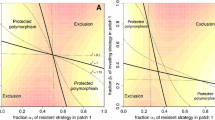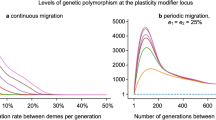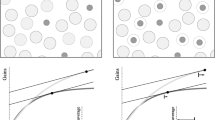Summary
Question: What are the conditions required for natural selection to produce phenotypes specially adapted to the various habitats available in nature?
Model: Assume there are two habitat types and one or two phenotypes of the same or different species. The phenotypes do not recognize any spatial differences among patches of the same habitat type. Possible evolutionary winners can do better in one habitat only by relinquishing some ability in the other.
Results: If only one phenotype is present, it will be an intermediate (unless one of the two habitat types is so rare and unproductive that its effects can be ignored by natural selection). Even if two phenotypes are introduced, natural selection should generally restore monomorphism if habitat selection is not ever favored (e.g. if search costs are high). But if search costs and environmental variation are zero, dimorphism can be expected. And if they are small, then although monomorphism is stable, its basin of attraction is small, and invasion by a second form (such as a sibling species) can provide the discontinuous jump needed to put the system in the other basin of attraction. Once there, dimorphic extremism coevolves. Each successful morph is as specialized as possible on one of the habitats. Competition between the morphs is eliminated. Environmental variation may constrict the basin, but once a point is captured by it, the system approaches dimorphic extremism anyway. In general, whatever promotes the behavior of habitat selection also promotes the evolution of extreme morphologies and physiologies.
Similar content being viewed by others
References
Brown, J. S. and Rosenzweig, M. L. (1986) Habitat selection in slowly regenerating environments.J. Theor. Biol. 123, 151–71.
Fretwell, S. D. (1972)Populations in a Seasonal Environment. Princeton University Press, Princeton, NJ.
Fretwell, S. D. and Lucas, Jr, H. L. (1970) On territorial behavior and other factors influencing habitat distribution in birds. I. Theoretical development.Acta Biotheoretica 19, 16–36.
Levins, R. (1962) Theory of fitness in a heterogeneous environment. I. The fitness set and adaptive function.Amer. Natur. 96, 361–73.
Mayr, E. (1954) Change in genetic environment as a process, p. 157–80. InEvolution as a Process (J. Huxley, C. A. Hardy and E. B. Ford, eds). G. Allen and Unwin, London. 367 p.
Morisita, M. (1950) Dispersal and population density of a water-strider,Gerris lacustris L. (in Japanese).Contr. Physiol. Ecol. Kyoto Univ., #65.
Pimm, S. L. and Rosenzweig, M. L. (1981) Competitors and habitat use.Oikos 37, 1–6.
Pimm, S. L., Rosenzweig, M. L. and Mitchell, W. (1985) Competition and food selection: field tests of a theory.Ecology 66, 798–807.
Rosenzweig, M. L. (1974) On the evolution of habitat selection.Pr. First Int. Congr. Ecol. 401–4.
Rosenzweig, M. L. (1979) Optimal habitat selection in two-species competitive systems.Fortschr. Zool. 25, 283–93.
Rosenzweig, M. L. (1981) A theory of habitat selection.Ecology 62, 327–35.
Rosenzweig, M. L. (1986) Hummingbird isolegs in an experimental system.Behav. Ecol. Sociobiol. 19, 313–22.
Rosenzweig, M. L. (1987) Community organization from the point of view of habitat selectors. InOrganization of communities: past and present, Symposium #27 of the British Ecological Society (P. Giller and J. Gee, eds). Blackwell Scientific, Oxford.
Schaffer, W. M. and Kot, M. (1986) Chaos in ecological systems: the coals that Newcastle forgot.Trends in Ecol. Evol. 1, 58–63.
Svardson, G. (1949) Competition and habitat selection in birds.Oikos 1, 157–74.
Author information
Authors and Affiliations
Rights and permissions
About this article
Cite this article
Rosenzweig, M.L. Habitat selection as a source of biological diversity. Evol Ecol 1, 315–330 (1987). https://doi.org/10.1007/BF02071556
Issue Date:
DOI: https://doi.org/10.1007/BF02071556




